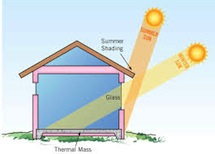3 Forms of Solar Energy For Homes and Buildings

There are three main ways we use the sun for energy in our custom homes and buildings. Here we offer a quick breakdown on solar energy from most cost-effective to least cost-effective. This generalization can be rearranged depending on design, location and individual situation.
1. Passive Solar Design (windows)
Passive solar design is mostly about window placement. It usually includes directional orientation, building shape, overhangs and can also describe other ways we block unwanted sunlight in warmer seasons. Altogether it's a big, dynamic subject.
Invite the winter sun, reject the summer sun.
Passive solar design is a unique form of solar energy for our homes and buildings. Its the only one capable of zero-extra upfront costs, requires no maintenance, and lasts as long as the home or building. It increases resilience in power outages and disasters.
 Passive Solar Design is our post dedicated to designing with the path of the sun.
Passive Solar Design is our post dedicated to designing with the path of the sun.
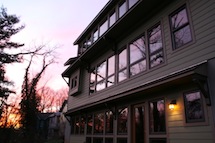
A Green Building Advisor article for designers, builders and homeowners looking to implement passive 
Cost-Effective Passive Solar Design

This article in Fine Homebuilding uses our Springtime Cottage as a starting point for passive solar design.
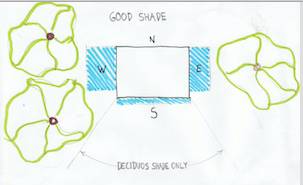
Summertime Passive Solar Design
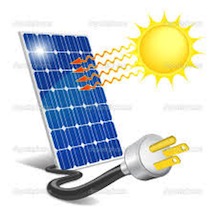 2. Solar Photovoltaics PV (electricity)
2. Solar Photovoltaics PV (electricity)
This fastest growing form of solar energy is creating electricity from sunlight. Falling panel prices, grid-tied systems and healthy tax incentives have pushed this form of solar energy into the mainstream. Even as the tax credits are expiring, this form of electricity generation is proving to be more cost effective than coal fired power plants, natural gas and nuclear.
The systems still have high upfront costs, but for long-term ownership, they are paying back upfront costs in 4-15 years on average, and pure profit after that. With no moving parts they require little maintenance. Possible 30-70 year lifespans.
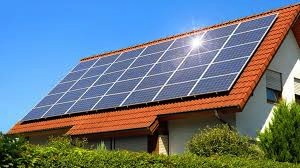 The coming battery revolution, including products like Tesla's power wall, will make this investment even more fruitful. PV combined with new battery storage options is currently transforming energy use as we know it.
The coming battery revolution, including products like Tesla's power wall, will make this investment even more fruitful. PV combined with new battery storage options is currently transforming energy use as we know it.
The technology is changing conventional wisdom about indoor combustion for heating and is driving further development of high efficiency heat pumps for serving our energy needs. The future is looking brighter already.
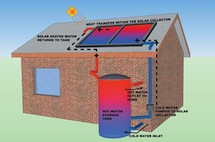 3. Solar Thermal (water)
3. Solar Thermal (water)
Solar thermal is using the sun's energy to heat water. Solar thermal water can be used in many interesting ways. Usually it's used for the most cost-effective water conservation subject of hot water; showering, clothes washers, sinks and dishwashers. Solar thermal can also be used in radiant floor heating applications.
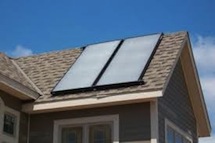 With the incredible progress of PV and heat-pumps the cost-effectiveness of solar thermal is being called into question. Some researchers suggest that solar thermal is dead, while others think we should stop picking on solar thermal. The main issue is maintenance. Climates with freezing weather can make long-term outlooks problematic.
With the incredible progress of PV and heat-pumps the cost-effectiveness of solar thermal is being called into question. Some researchers suggest that solar thermal is dead, while others think we should stop picking on solar thermal. The main issue is maintenance. Climates with freezing weather can make long-term outlooks problematic.
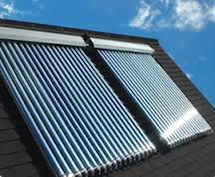 I like solar thermal for certain situations. It is still one of the most efficient ways to heat water. For those with high energy costs, off-grid scenarios or for homeowners that like to tinker or don't mind ocasional maintenance, they can be a good investment. For most of our custom home projects, I advise using heat pump water heaters and investing in PV provisions, even if its just a conduit to the breaker box for the future.
I like solar thermal for certain situations. It is still one of the most efficient ways to heat water. For those with high energy costs, off-grid scenarios or for homeowners that like to tinker or don't mind ocasional maintenance, they can be a good investment. For most of our custom home projects, I advise using heat pump water heaters and investing in PV provisions, even if its just a conduit to the breaker box for the future.
All three forms in harmony

Passive solar designed windows capture free heat throughout the winter. Solar PV on the main roof generates electricity for the grid-tied system. The solar thermal uses ground-mounted, evacuated tube collectors to capture heat for the home's domestic hot water use.
A small PV panel above the ground mount collector, powers the circulator for the solar thermal system. It's a more passive form of solar thermal, providing hot water during outages and disasters, for situations that maintain water pressure like city water, gravity-fed water and generator or PV powered well pumps.
All three forms of solar energy reduce dirty energy costs, green building's most important priority. Heating and cooling is currently the biggest energy demand and cost-effective water conservation plays an important role.
 Green Building's Top 3 Priorities
Green Building's Top 3 Priorities  Heating and Cooling in WNC
Heating and Cooling in WNC  Cost-Effective Water Conservation
Cost-Effective Water Conservation
Springtime Builders builds custom homes in Asheville NC and specializes in cost-effective energy efficiency, building science and indoor-air quality.
Posted in Energy
